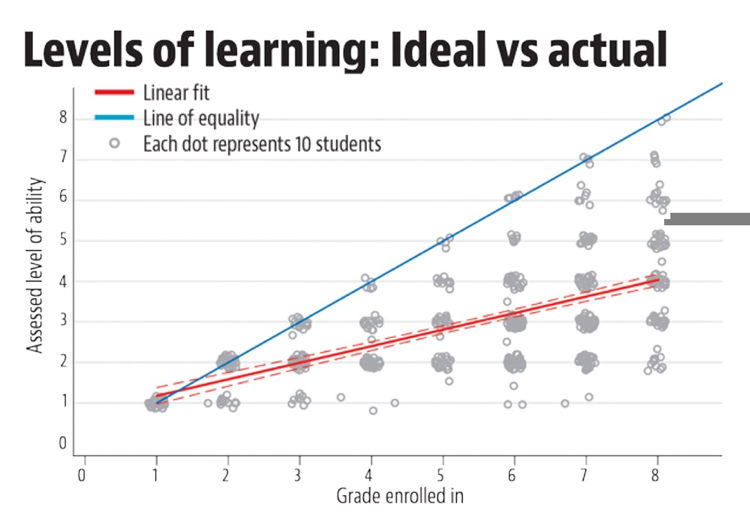Michelle Kaffenberger
Blavatnik School of Government, University of Oxford
Blog
Proposed changes to the Sustainable Development Goals’ education indicators would shift the focus away from early mastery of basic skills. Learning in the early years is critical for achieving later learning—evidence is increasingly showing that children who fall behind in early primary school rarely catch up. To achieve SDG 4 of quality education for all, we must know what children are learning (or not) early in the primary cycle. We would recommend that the SDG indicator 4.1.1 text below stay as it is.
The Inter-Agency and Expert Group on Sustainable Development Goal Indicators (IAEG-SDG) is holding an open consultation on the proposed changes, and you too can make your voice heard by filling out this consultation form before Sunday, September 8.
The first target for Sustainable Development Goal 4 calls on the international community to ensure all children “complete equitable and quality primary and secondary education leading to relevant and effective learning outcomes.” This is being tracked by an indicator that requires measuring learning among children at multiple points in their schooling:
SDG 4.1.1: The proportion of children and young people (a) in Grades 2/3 (b) at the end of primary school; and (c) at the end of lower secondary achieving at least a minimum proficiency level in (i) reading and (ii) mathematics.
Worryingly, the IAEG-SDG is proposing to replace this with an indicator that tracks literacy and numeracy in the general population (disaggregated by age, gender, and education level):
Proposed new indicator (to replace current indicator): Proportion of the population achieving at least a minimum level of proficiency in (a) literacy and (b) numeracy skills, by sex, age, and educational level.
While the difference may seem small, it matters. Indicators get measured, and what gets measured gets done (or at least the converse, what does not get measured does not get done). The proposed language might be interpreted as including measurement at specific levels, but it is much less clear. By not specifying that learning should be measured for children at multiple stages of primary school (early, Grades 2/3, and at the end) and in lower secondary school, this indicator could be tracked without any information on the learning currently occurring in schools. Retrospective data on learning among young adults of varying ages and varying levels of schooling completion (like the current DHS for instance) might be taken to satisfy this indicator, but would give no information on what primary school students are currently learning and hence when they start falling behind. Measuring literacy and numeracy in this way will provide too little information too late in the education cycle to be useful to countries working to overcome the learning crisis.
Learning in the early years is critical in determining a child’s learning outcomes and prospects for achieving more advanced skills. If children fall behind on the early parts of the curriculum, they often fail to catch up. This is especially true of foundational literacy and numeracy skills, on which the rest of the curriculum often depends. A recent study in Delhi found that once students fell behind the curriculum, many never caught up. Figure 1 from this study shows that many children are still at Grade 2 levels in Grade 3—and then many stay there in Grades 4, 5, 6, and 7. As the children never mastered Grade 2 skills, they were unable to move on to more advanced skills. Growing evidence from studies of learning profiles shows that when children don’t master skills early, they often remain on a flat trajectory and rarely catch up later.
Figure 1. Children who fall behind in the early years of school often fail to catch up

By tracking learning at several points in the basic education cycle, the current indicator can help identify when students are falling behind, what skills they are not gaining, and which groups of students are most likely to fall behind. This can inform reforms to the education system and curriculum to help get, and keep, children on track. Measuring such skills among older groups such as youths (and certainly among adults) presents a lag that does not reflect the current status of learning in an education system.
Ensuring that all children acquire the basic skills they need to develop their full capacities as individuals and citizens has been at the core of the global education agenda at least since the launch of the global Education for All movement with the Jomtien Declaration in 1990. Achieving this requires tracking learning in the early years to ensure children achieve early mastery of basic skills preparing them for more advanced learning. To this end, we believe SDG 4.1.1 needs to remain in place in its current form. We’re sharing our thoughts on this change with the IAEG-SDG, and you too can weigh in with your views by filling out the open consultation form (deadline September 8).
RISE blog posts and podcasts reflect the views of the authors and do not necessarily represent the views of the organisation or our funders.